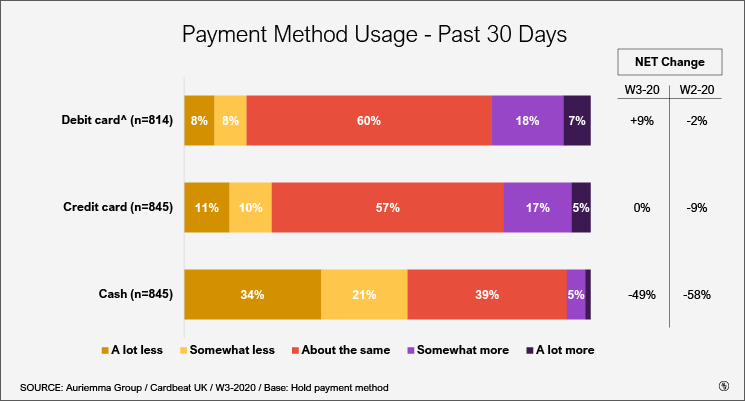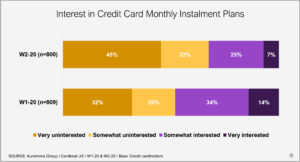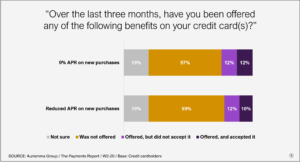(New York, NY and London, UK) COVID-19 has significantly impacted most aspects of consumer’s lives, including how they shop and make payments. People are concerned for their finances, their health, and are uncertain about the future. Auriemma Group conducted studies in the US and the UK to understand how payment activity and expectations are changing, and what issuers can do to meet this unprecedented moment in our history.
How Payment Activity Is Changing
Across both markets, about seven-in-ten consumers are anxious about the future. Many are specifically concerned about their personal finances, especially in the US (81% vs. 67% UK). This worry, paired with stay-at-home guidance and closures of non-essential businesses have altered the way many consumers make purchases, what they are purchasing, and their purchasing power.
COVID-19 has caused many to shift spend online. Nearly eight-in-ten consumers are visiting fewer businesses and, as a result, many are placing more online orders than usual (45% US vs. 38% UK). However, most have reduced their non-essential spend, particularly in the UK (72% vs. 65% US).
Spend categories and payment methods have seen immediate shifts because of COVID-19. As a category, consumers understandably noted rises in grocery spend, with many saying they stocked up on food or household items (60% US vs. 49% UK). In addition, many are making more purchases with contactless or mobile payment options (34% US vs. 45% UK). This is unsurprisingly greater in the UK, given their tenure with contactless payments.
Changes in spend are similar across geographies. Over four-in-ten say they are spending less than typical (42% US vs. 47% UK), while only slightly fewer say spend stayed the same (41% vs. 35%). The remaining one-fifth say they are spending more than typical, and the average increase in monthly spend among that group was similar across both countries ($524 vs. £463).
“While sudden shifts in behavior are to be expected, the bigger question is whether these changes will be long-lasting,” says Jaclyn Holmes, Director of Research at Auriemma Group. “Many consumers are trying new purchasing channels and methods out of necessity, and some who were previously averse to online shopping are finding the experience to be surprisingly enjoyable. Only time will tell if these options truly become ubiquitous as a result.”
How Expectations Are Changing
Financial institutions play a key role in quelling the anxiety consumers in both markets face. From a communications perspective, banks and issuers are performing strongly. About three-quarters in both geographies say they are satisfied with the COVID-related communications coming from their primary bank or credit card issuer.
In addition to strong communication, consumers expect payment leniency. Over seven-in-ten said they expect their financial institutions to be understanding of late payments at this time. With some consumers unable to meet their payment obligations, about one-in-ten say they have missed a credit card, bill, or loan payment because of COVID-19.
Most issuers are meeting consumer expectation and waiving missed payment and late fees, but a handful report that the fee was not waived. This is especially true of UK consumers—36% who were charged a fee did not have it waived (vs. 27% US).
“Waiving fees is one way to show consumers that you are in their corner,” says Holmes. “And while that may not be fiscally possible for all issuers, offering support in other ways—be it via online tools and information, offers, or exemplary customer service—could go a long way to showing cardholders that you have compassion for their situation.”
What Issuers Can Do
Since its outbreak, COVID-19 has brought about many questions that lack answers. From health to the economy, there is a lot of uncertainty in what lies ahead, and customers are looking to their card issuers for guidance and reassurance. Issuers aiming to present a customer-first approach may want to communicate the following:
- Actions taken to help ease payment burdens (e.g., waived fees, lower rates, extended grace periods)
- Recommended customer service channels or resources (e.g., new channels aimed to reduce wait times, self-servicing options, updated FAQ pages)
- Beneficial information to aid the shopping experience (e.g., how to reduce direct contact using contactless or mobile payment options, merchant partner deals to help them save, how to maximize rewards)
- Steps to take when requesting a refund or filing a dispute
“Given how quickly things are changing, finding relevant and up-to-date information can become challenging for consumers,” say Holmes. “By providing thoughtful and consistent communications, issuers can help reduce rather than contribute to the mounting concern consumers are expressing.”
Survey Methodology
Cardbeat US
This Auriemma Group study was conducted online within the US by an independent field service provider on behalf of Auriemma Group (Auriemma) in March/April 2020 among 807 adult credit cardholders. The number of interviews completed for both is sufficient to allow for statistical significance testing among sub-groups at the 95% confidence level ±5%, unless otherwise noted. The purpose of the research was not disclosed, nor did respondents know the criteria for qualifying. The average interview length was 25 minutes.
Cardbeat UK
This Auriemma Group study was conducted online within the UK by an independent field service provider on behalf of Auriemma in April 2020, among 809 adult credit cardholders. The number of interviews completed on a monthly basis is sufficient to allow for statistical significance testing between sub-groups at the 95% confidence level ± 5%, unless otherwise noted. The purpose of the research was not disclosed nor did the respondents know the criteria for qualification.
About Auriemma Group
For more than 30 years, Auriemma’s mission has been to empower clients with authoritative data and actionable insights. Our team comprises recognized experts in four primary areas: operational effectiveness, consumer research, co-brand partnerships, and corporate finance. Our business intelligence and advisory services give clients access to the data, expertise and tools they need to navigate an increasingly complex environment and maximize their performance. Auriemma serves the consumer financial services ecosystem from our offices in New York City and London. For more information, call Jaclyn Holmes at (+1) 646-454-4200.














 And although consumers have historically preferred in-store shopping for groceries (and most still do), a notable 31% say they prefer using digital channels (i.e., websites, mobile apps) to make grocery purchases.
And although consumers have historically preferred in-store shopping for groceries (and most still do), a notable 31% say they prefer using digital channels (i.e., websites, mobile apps) to make grocery purchases.








